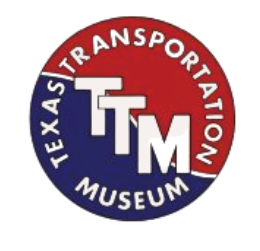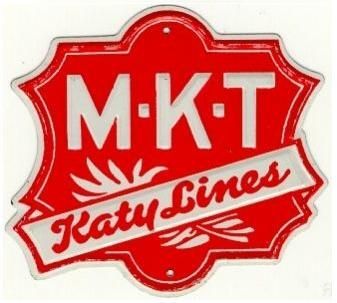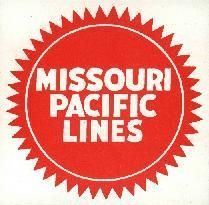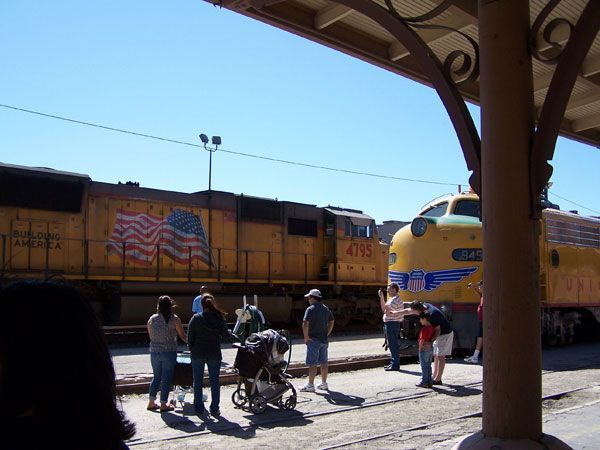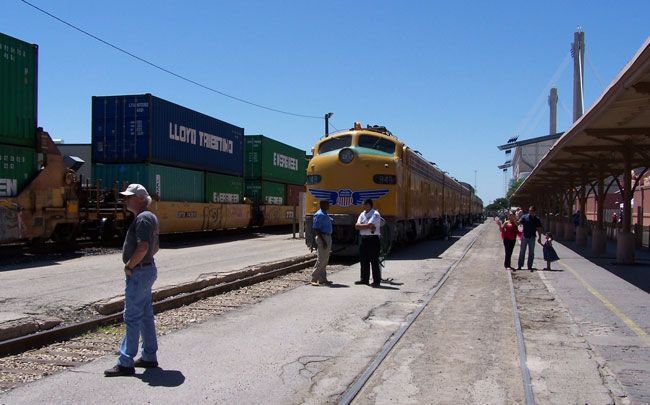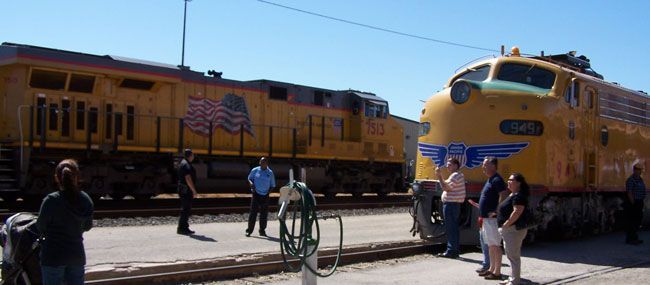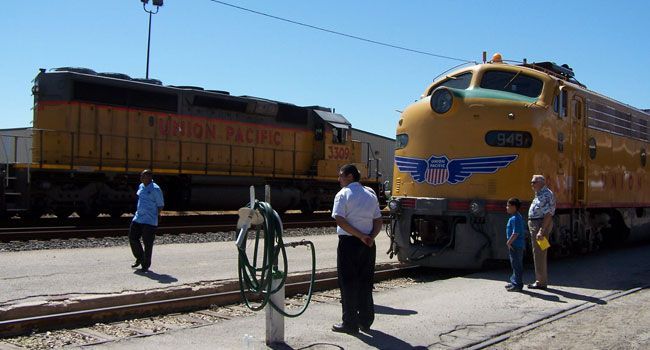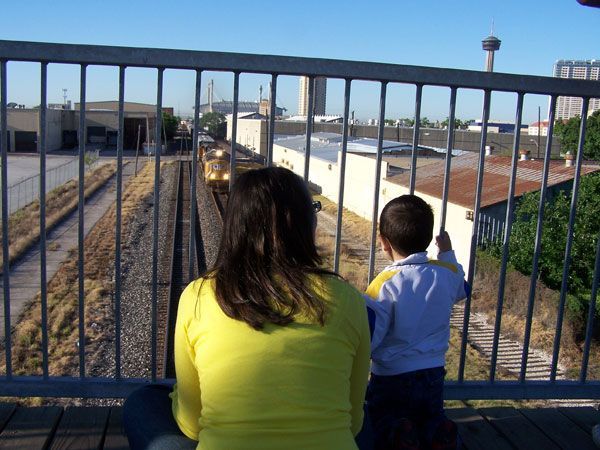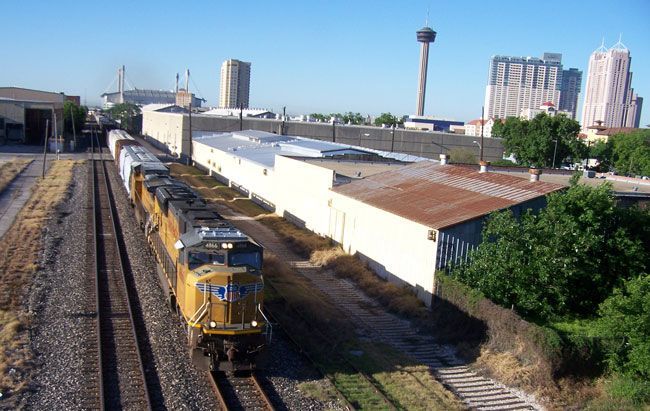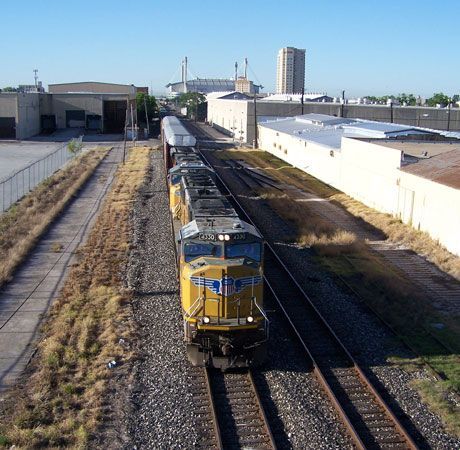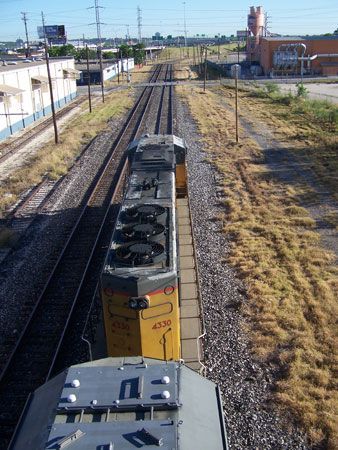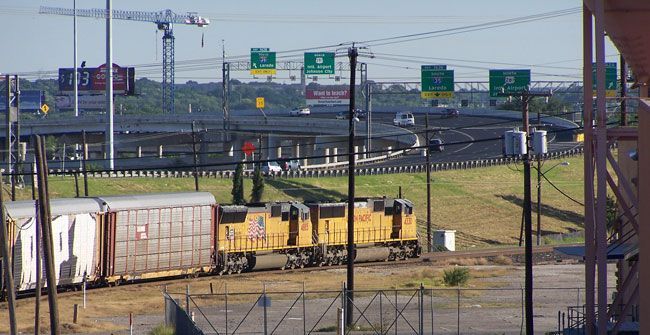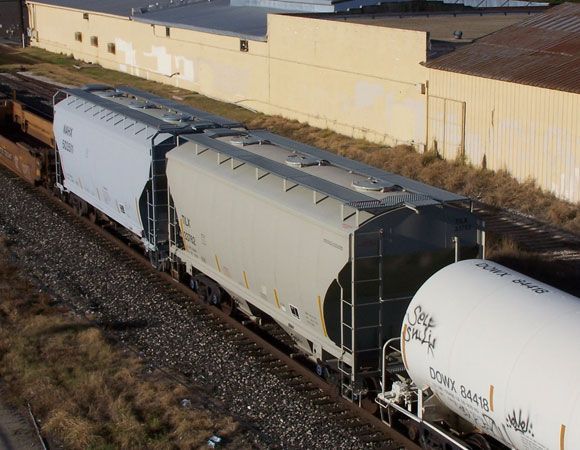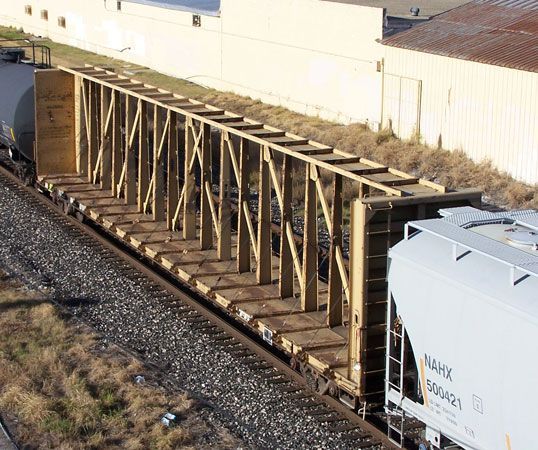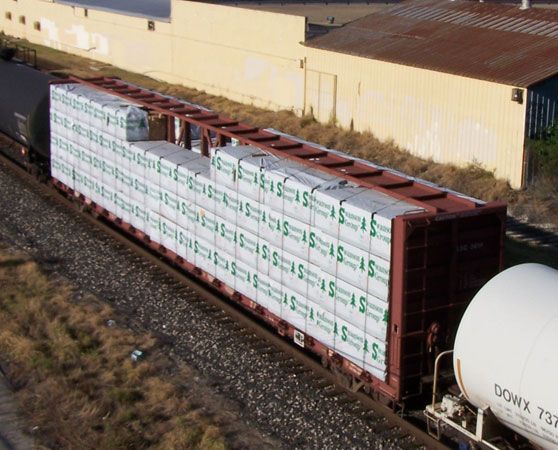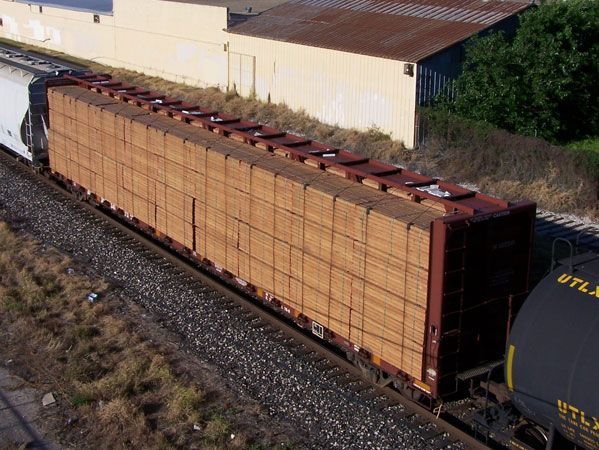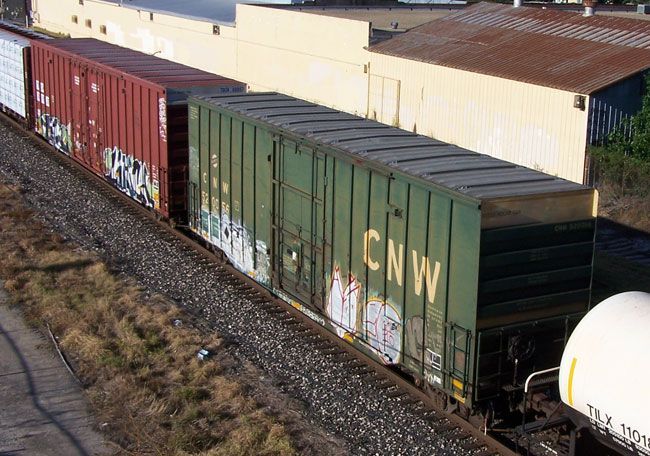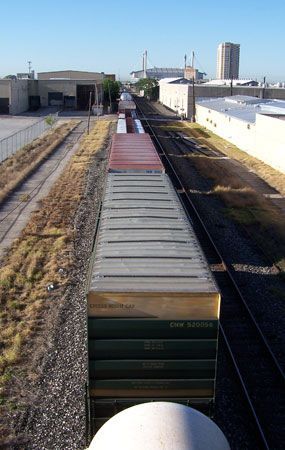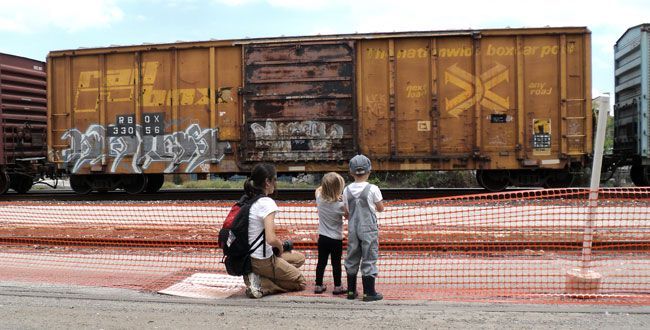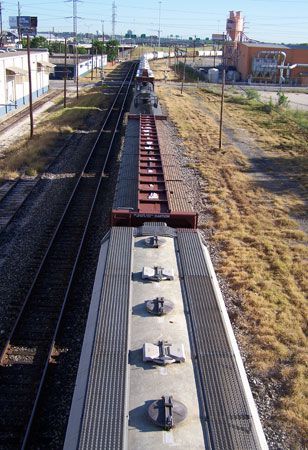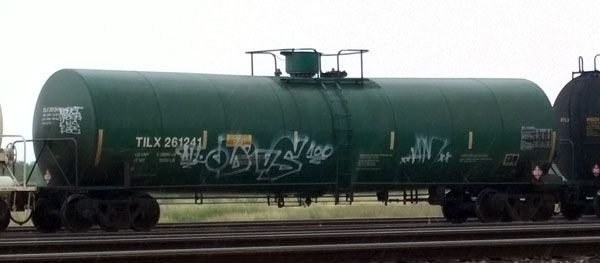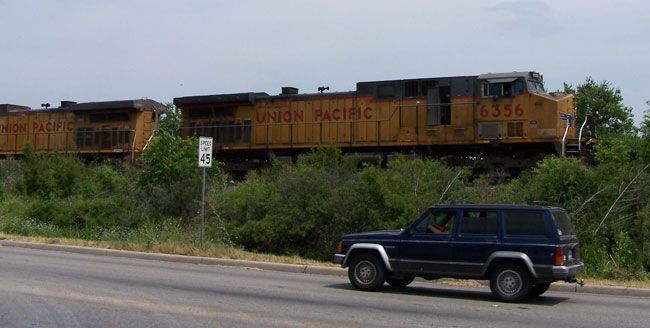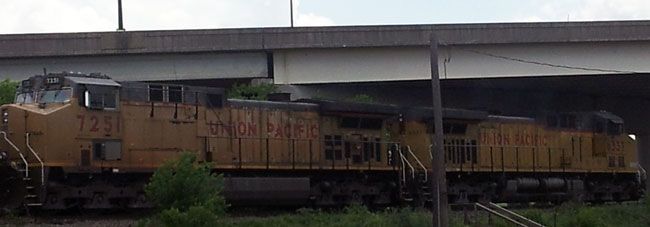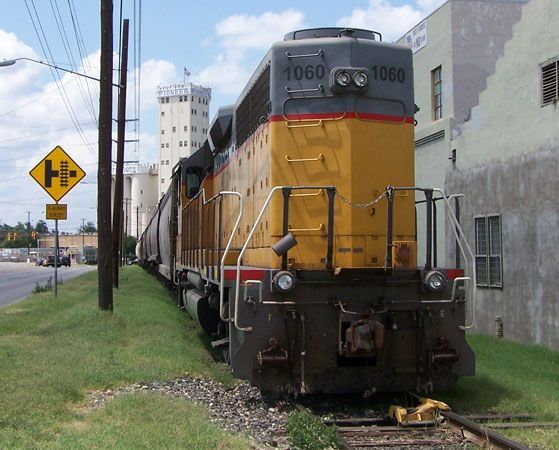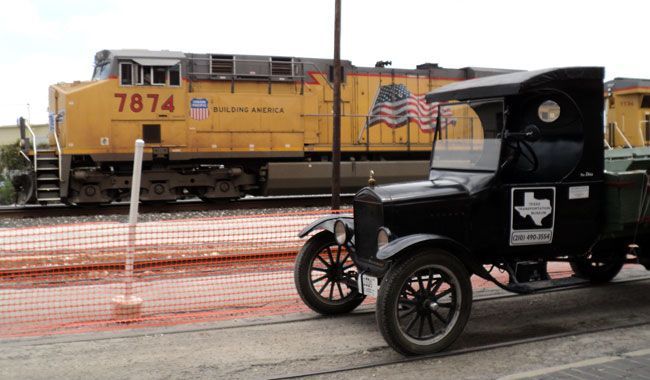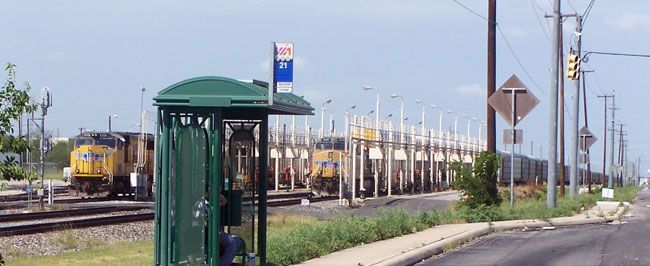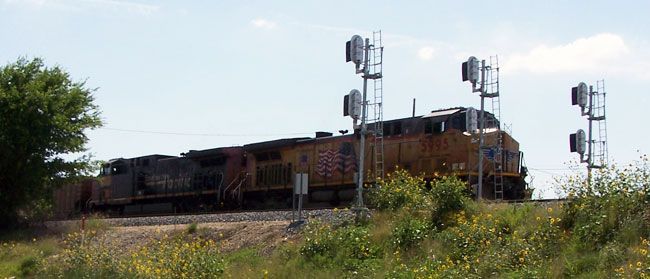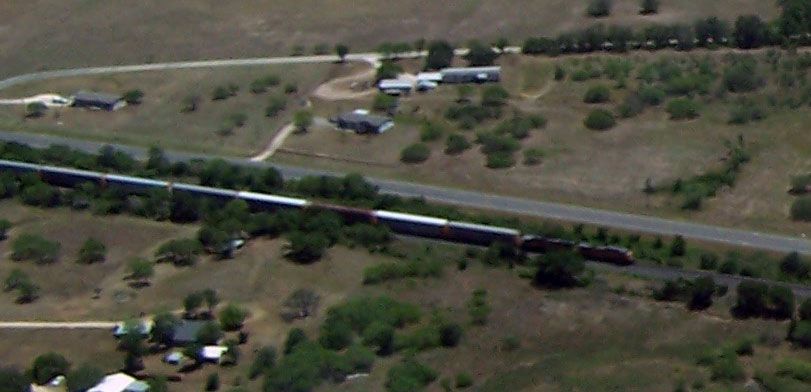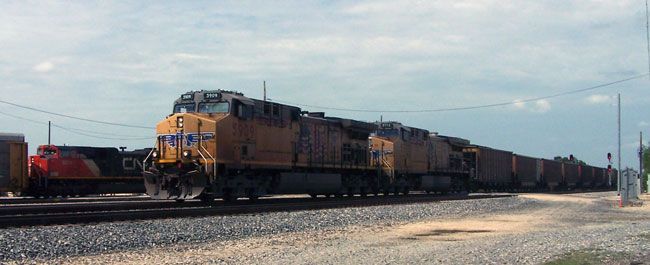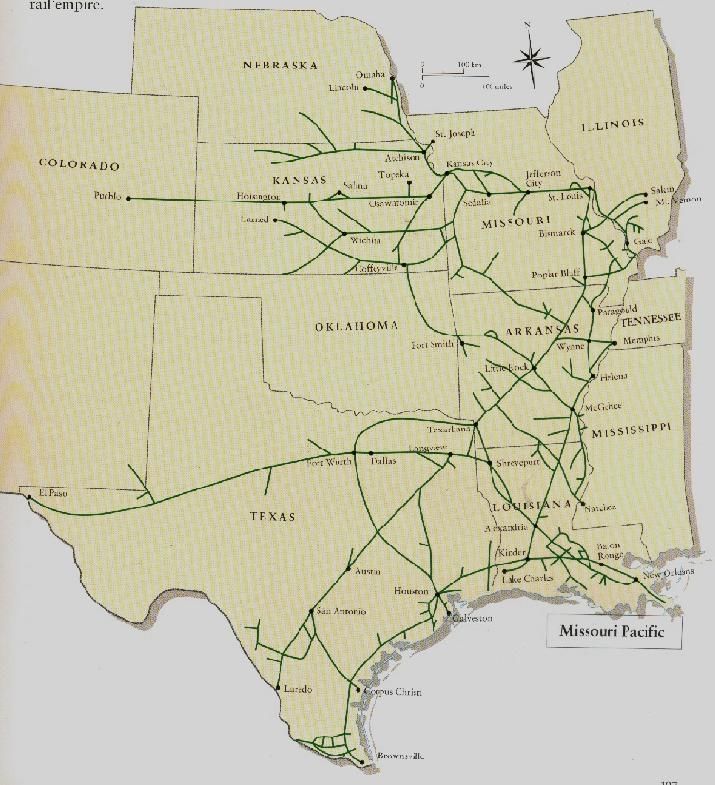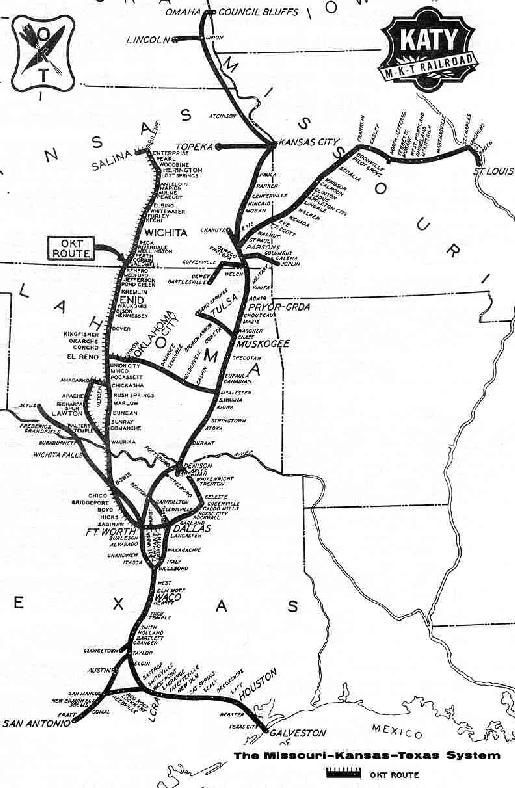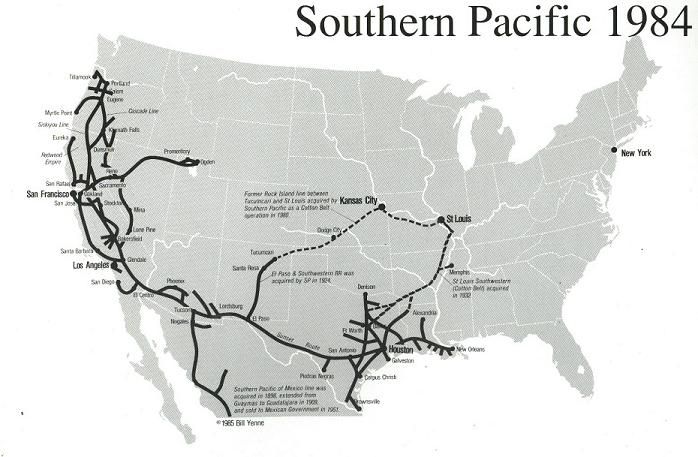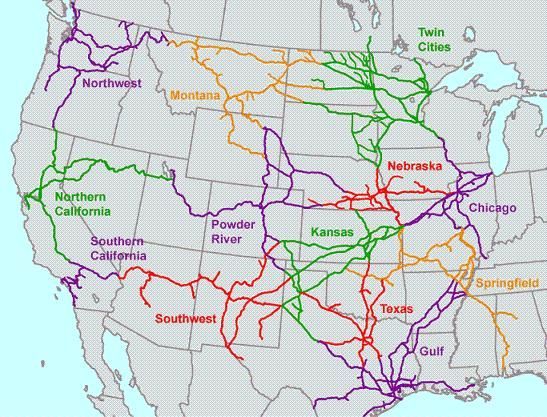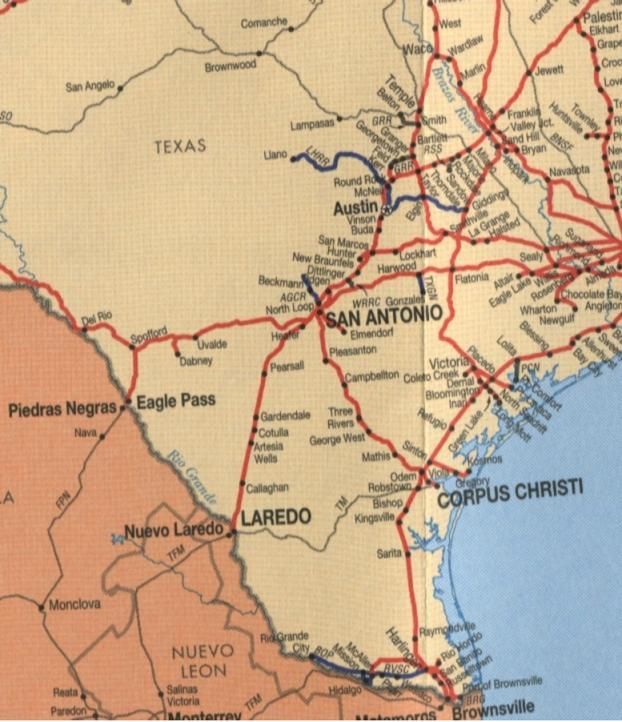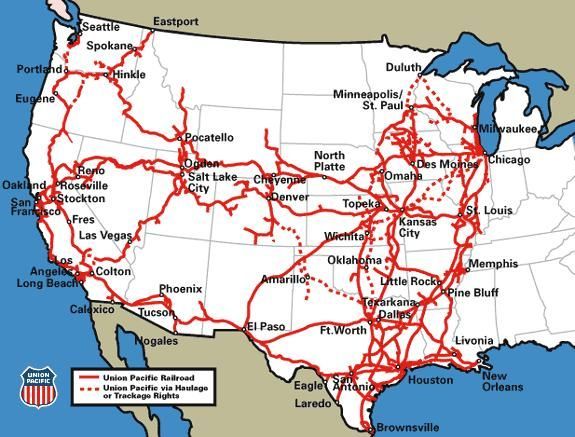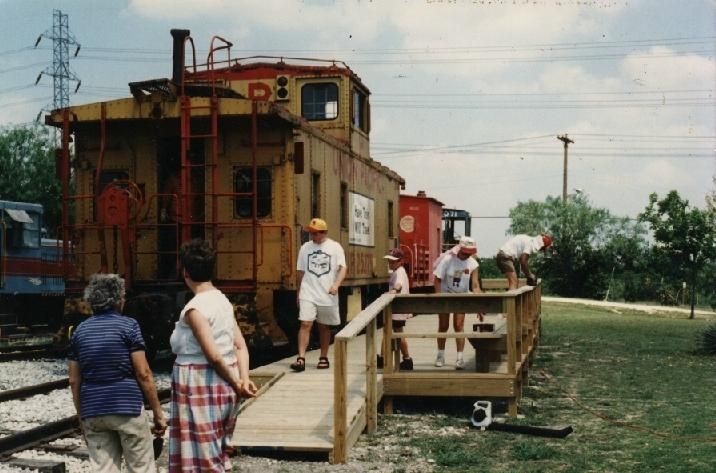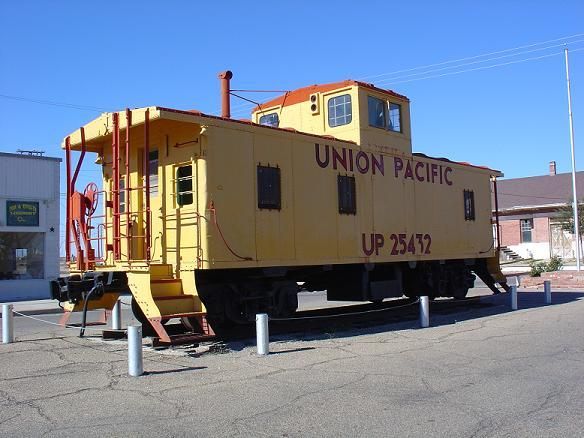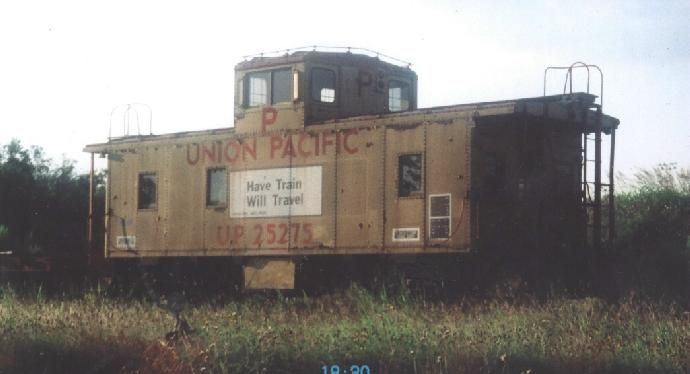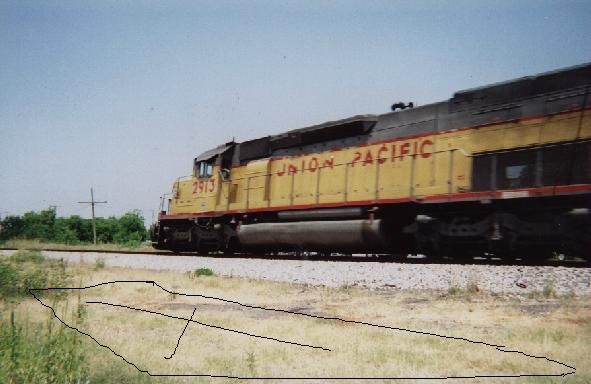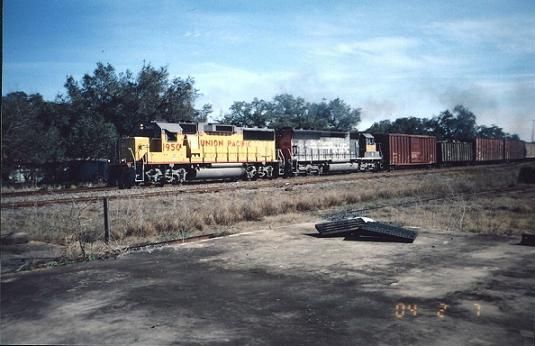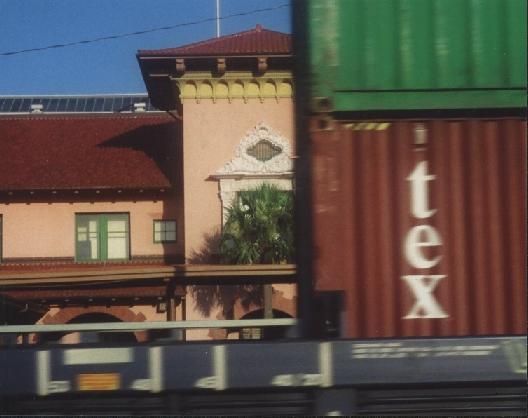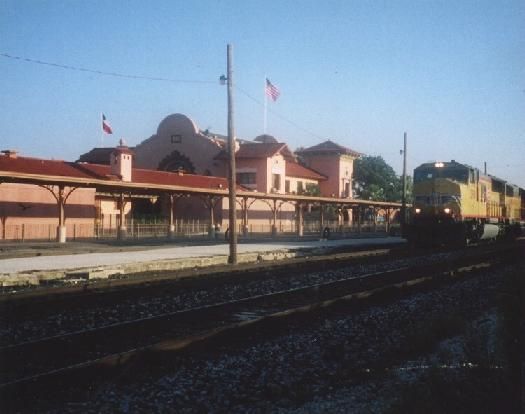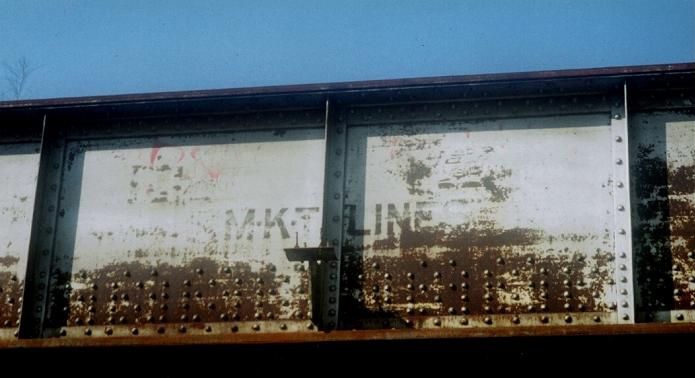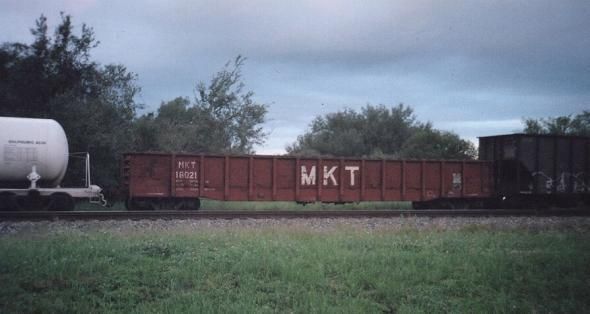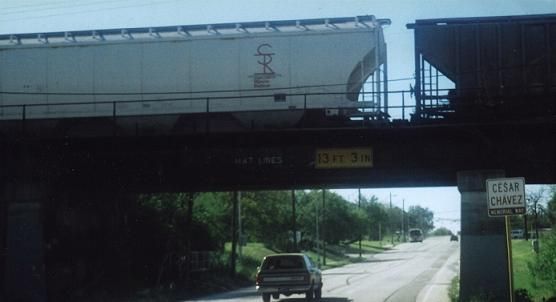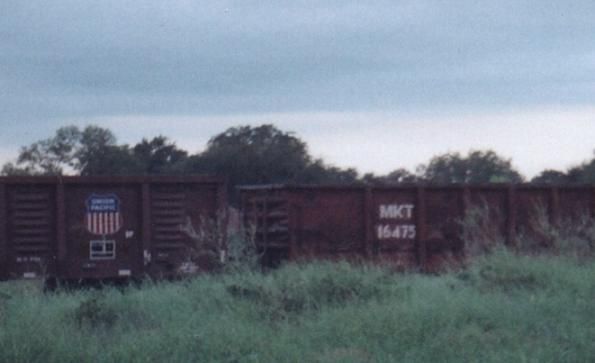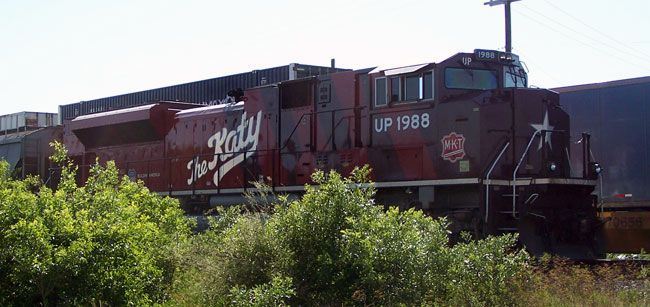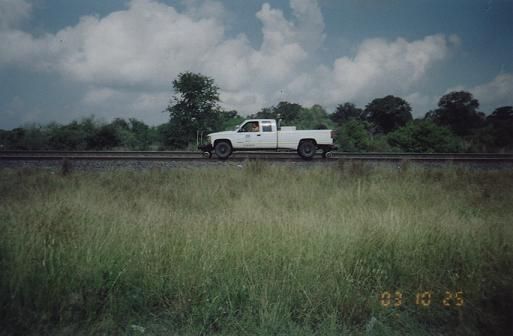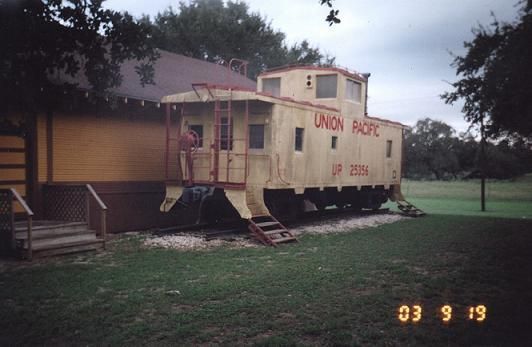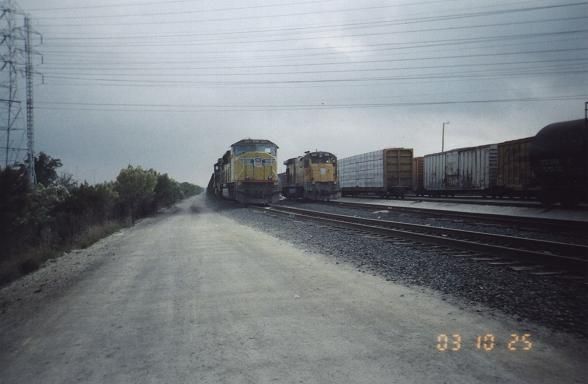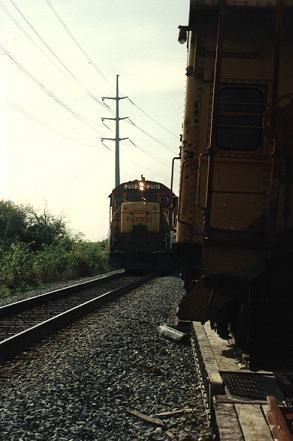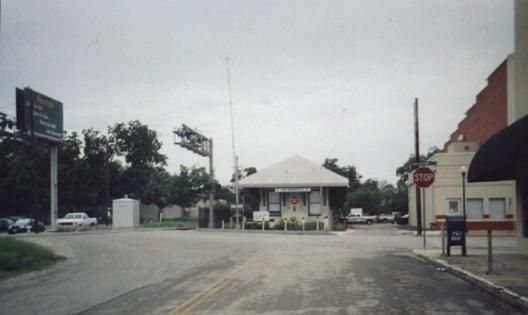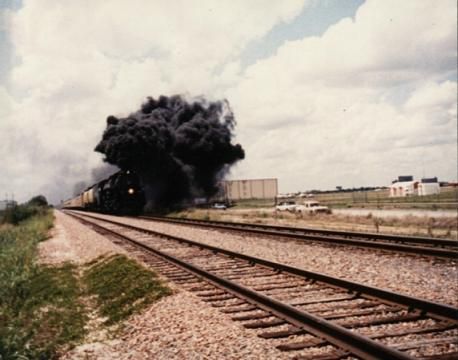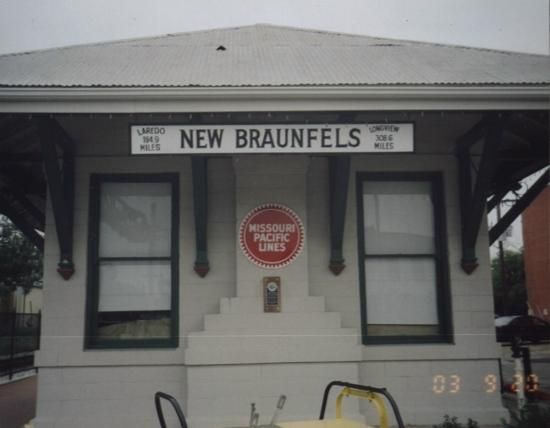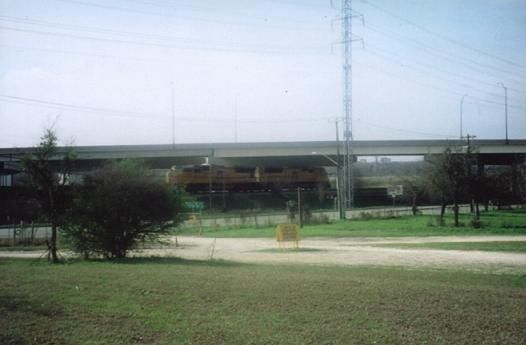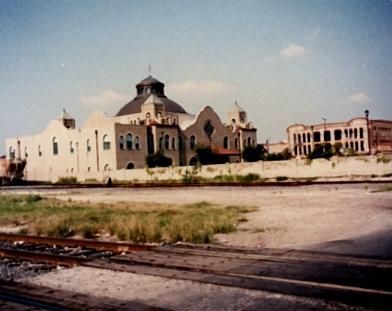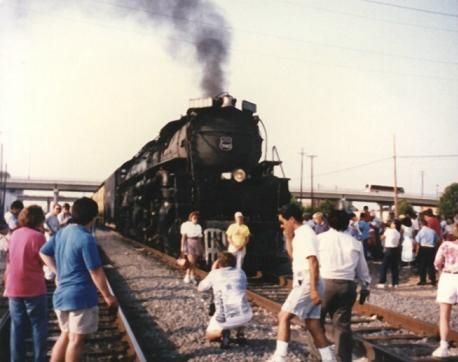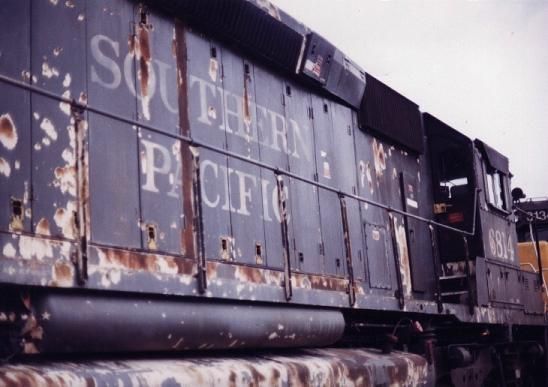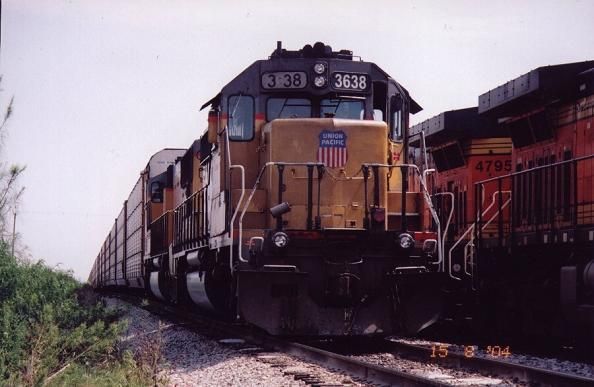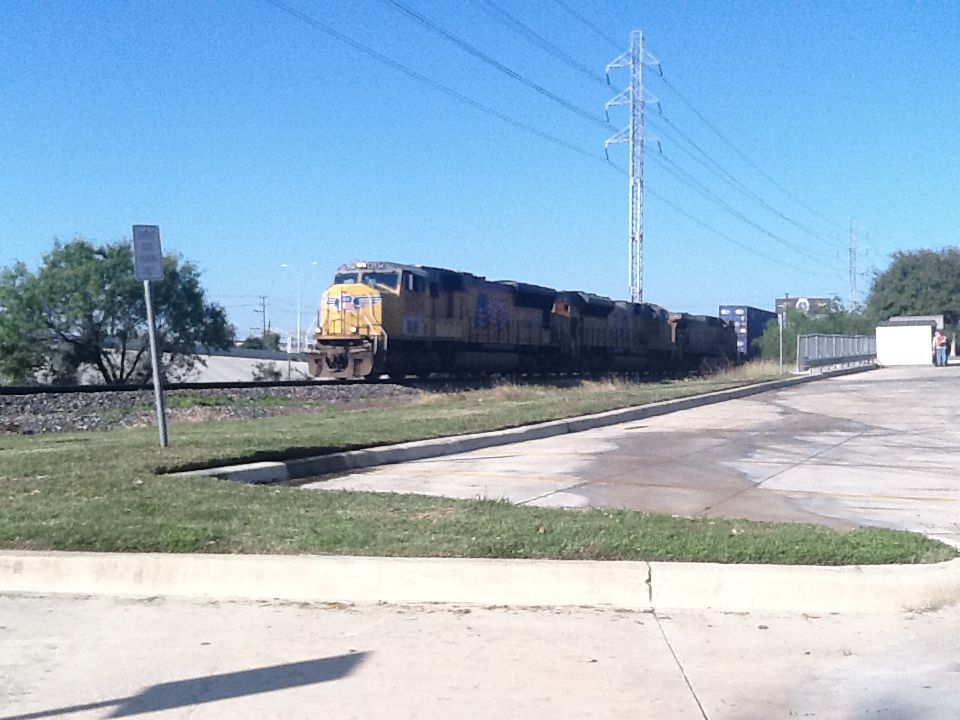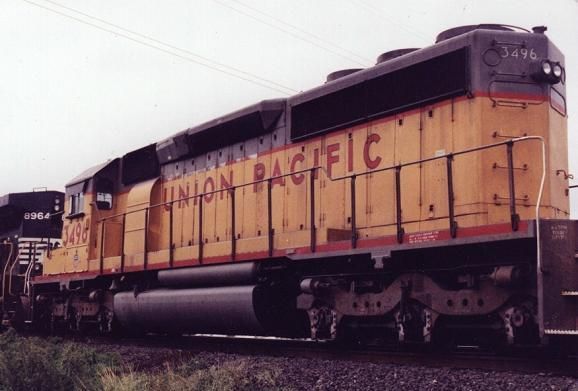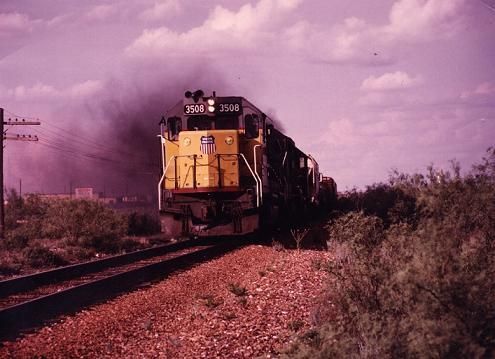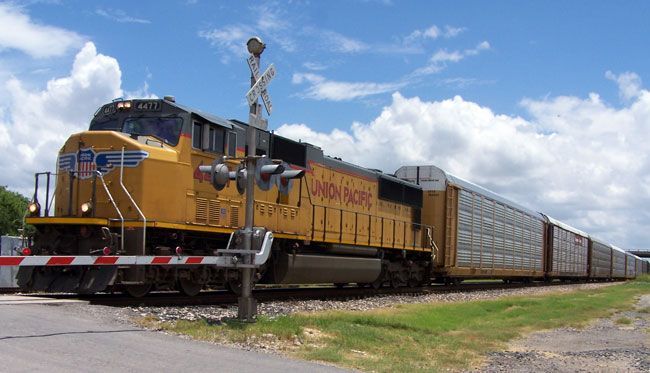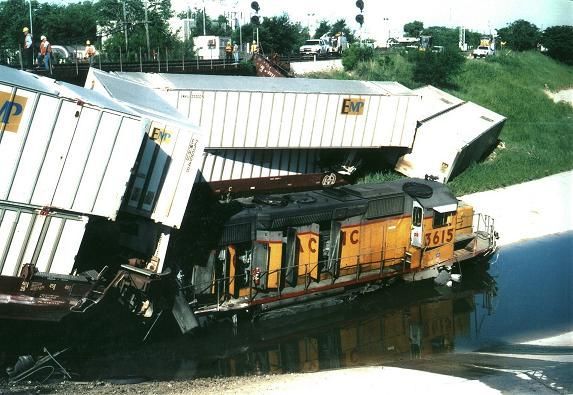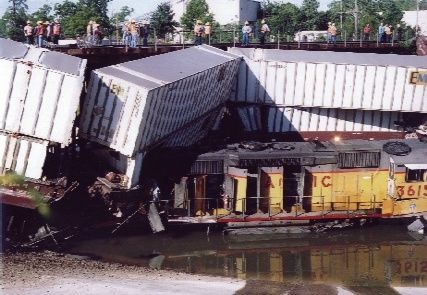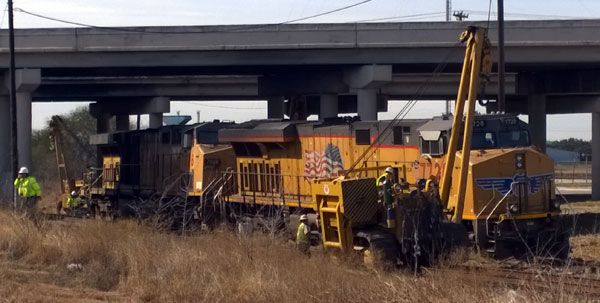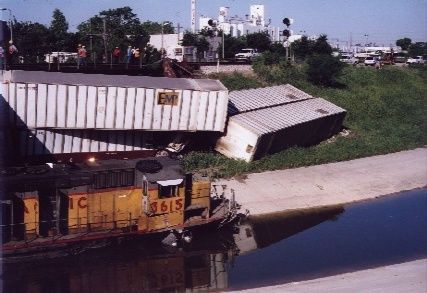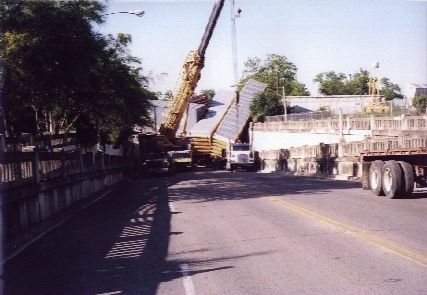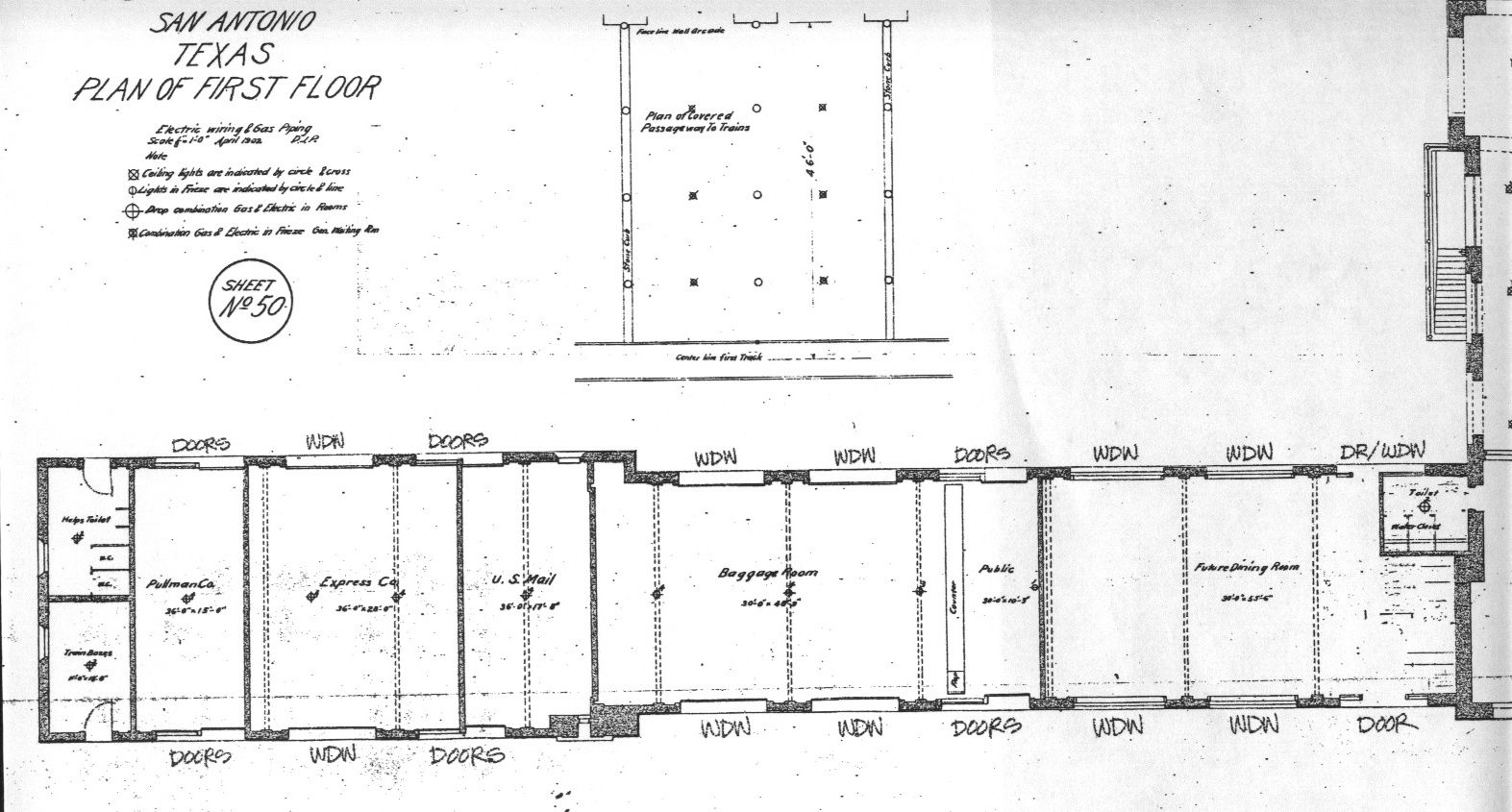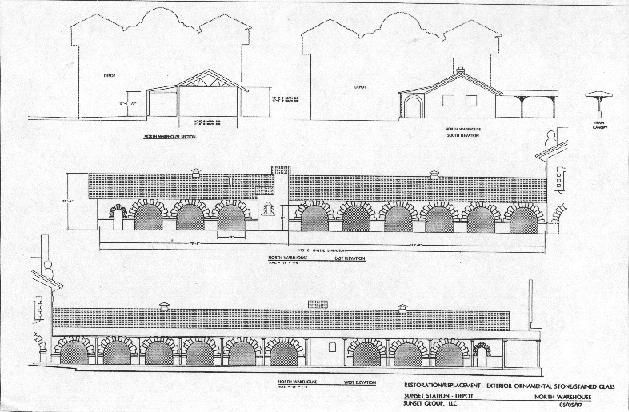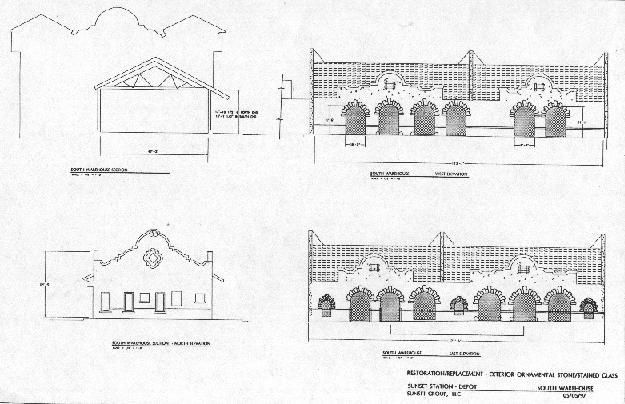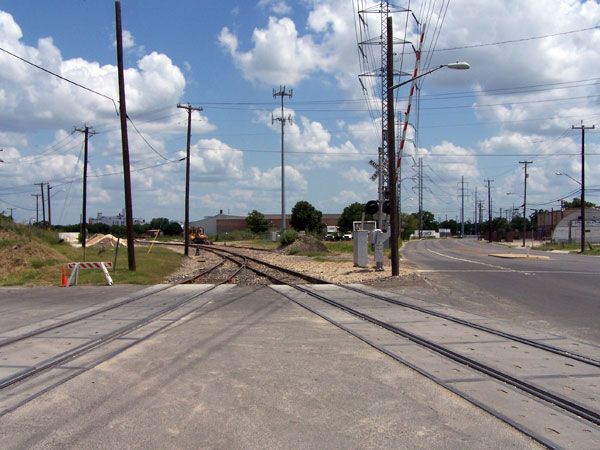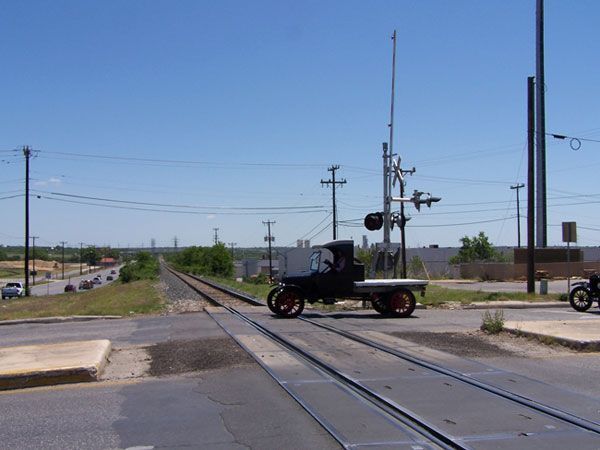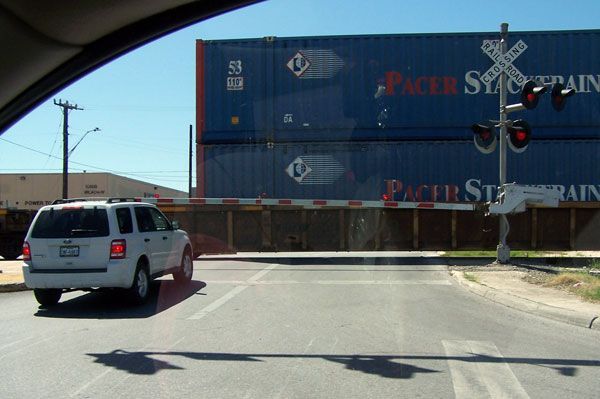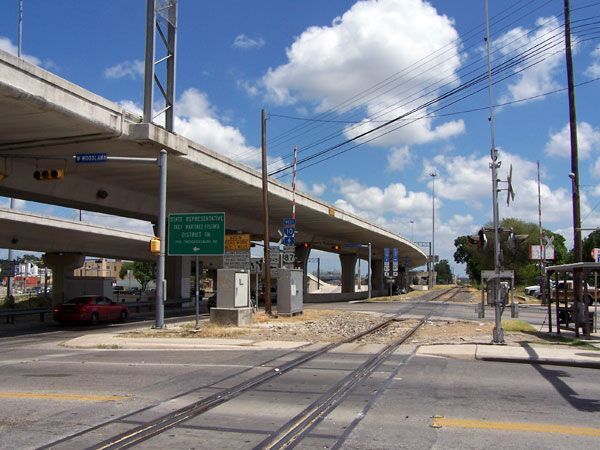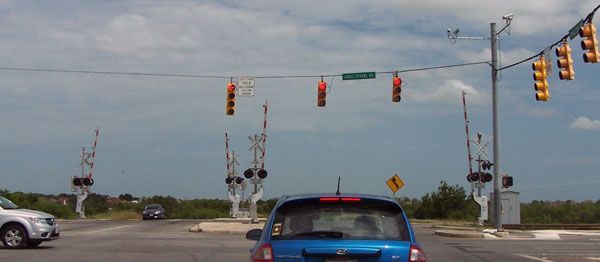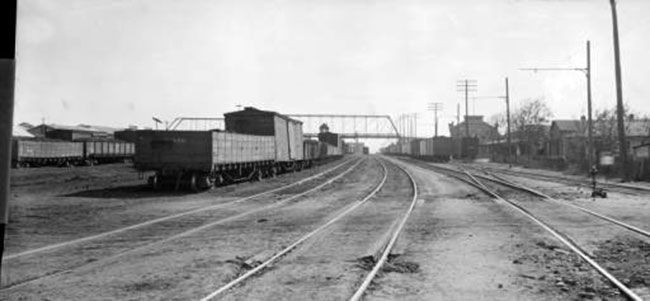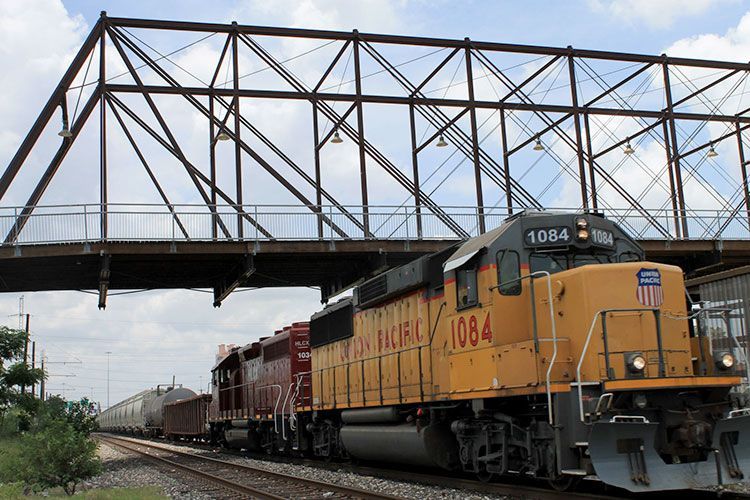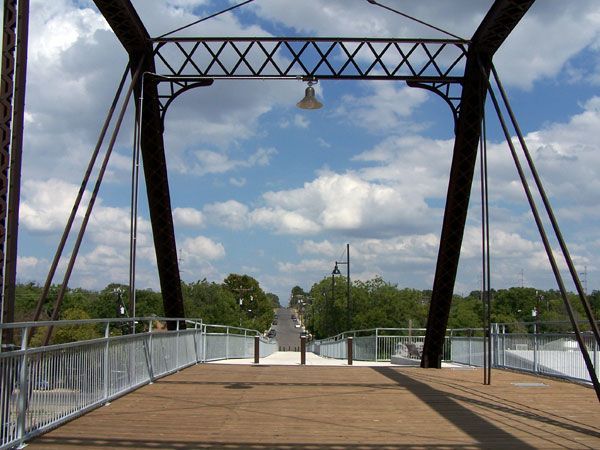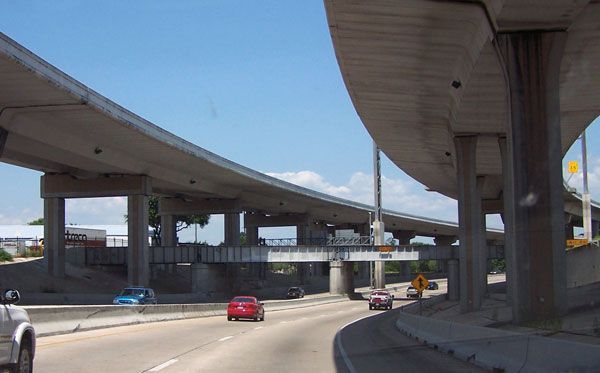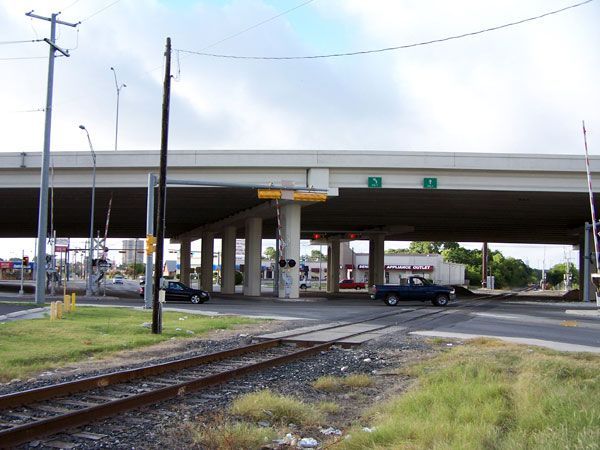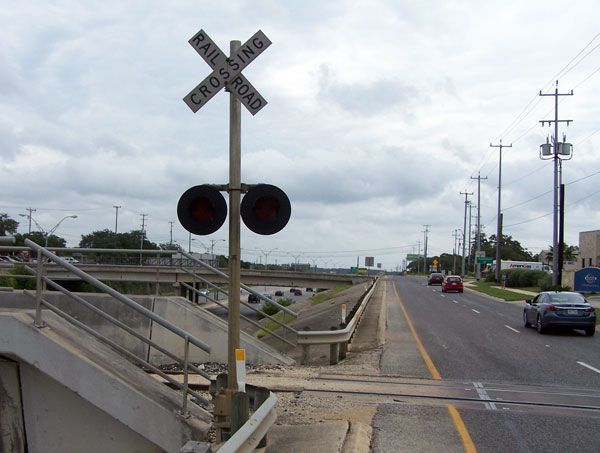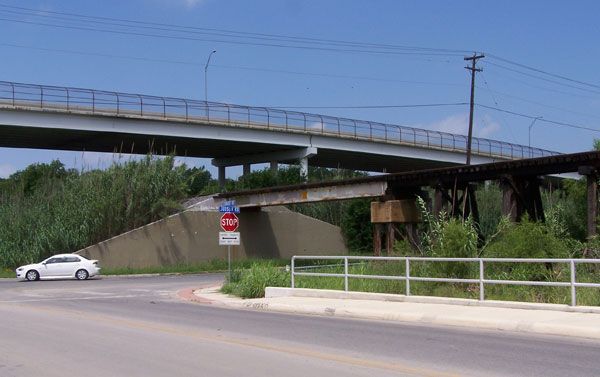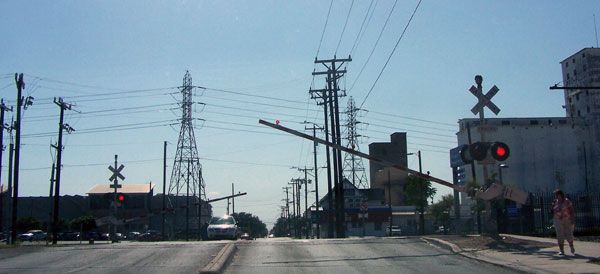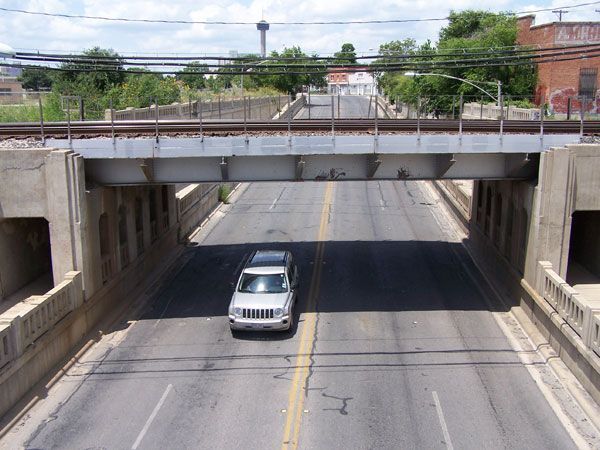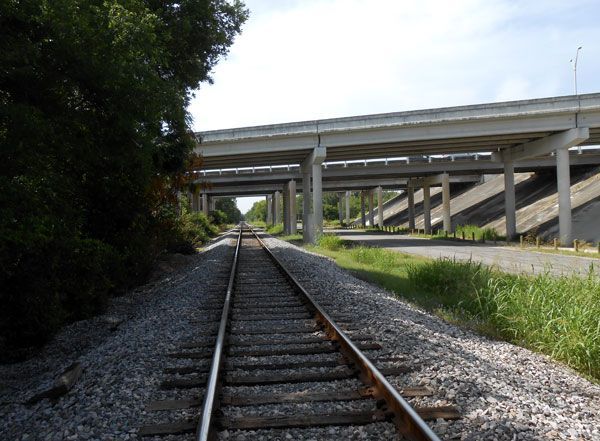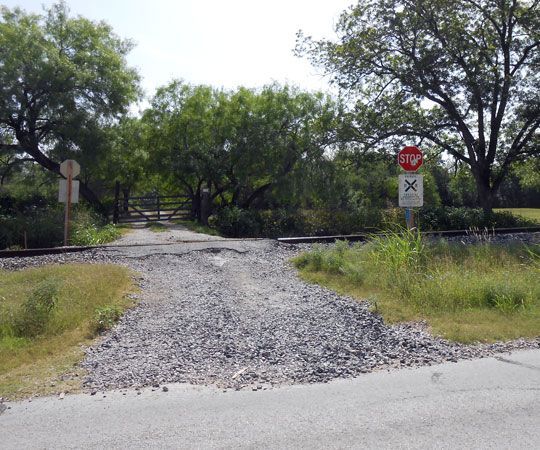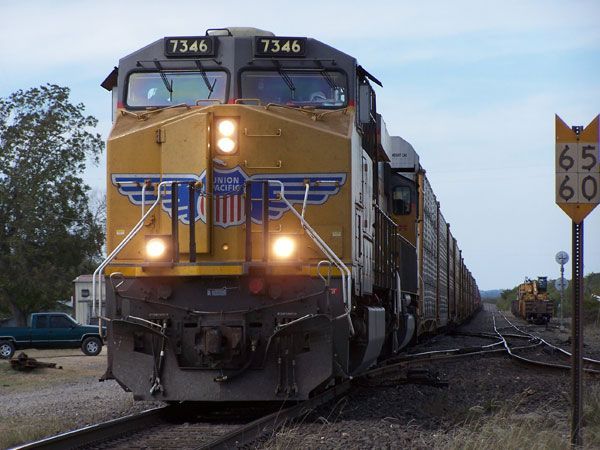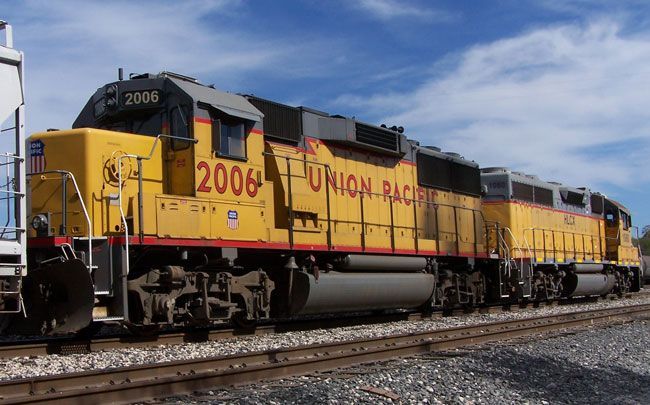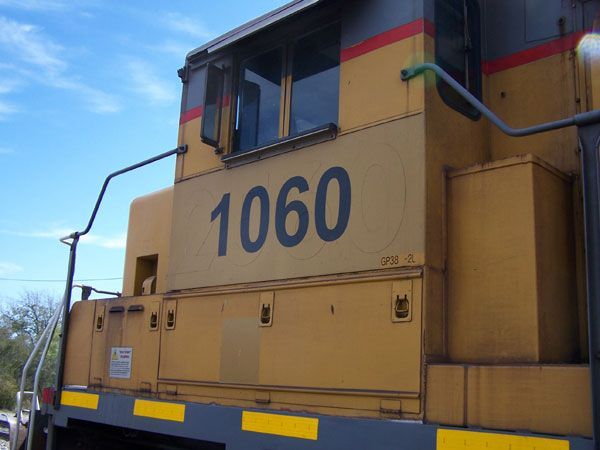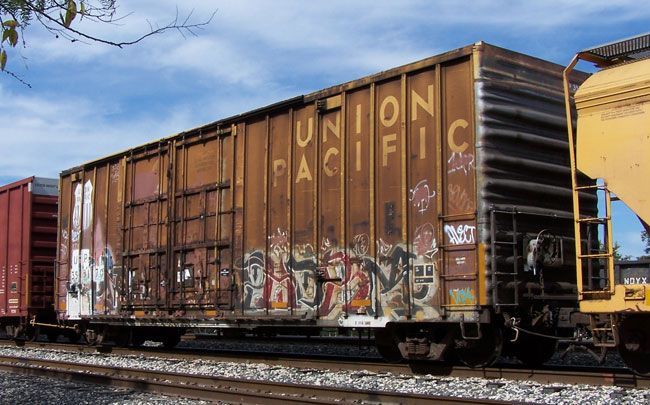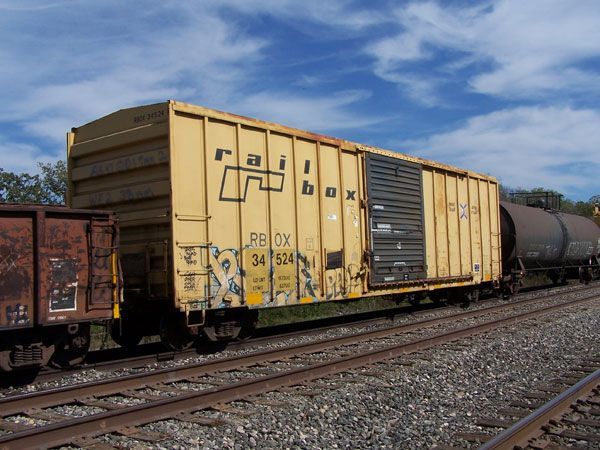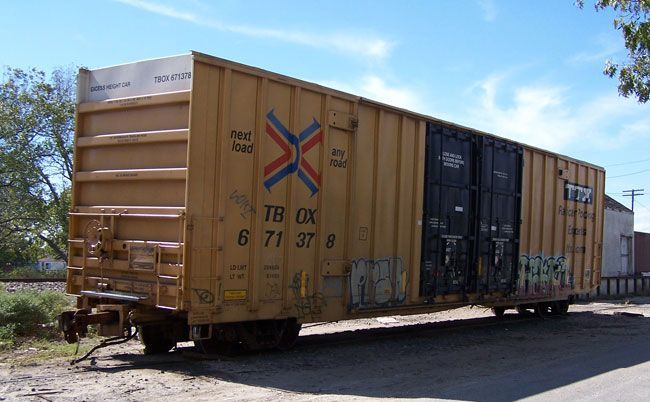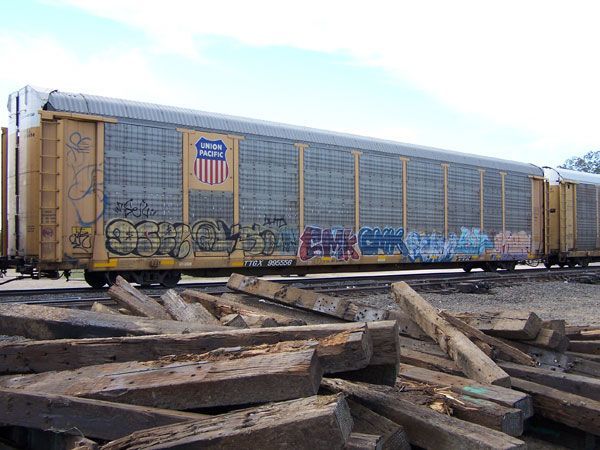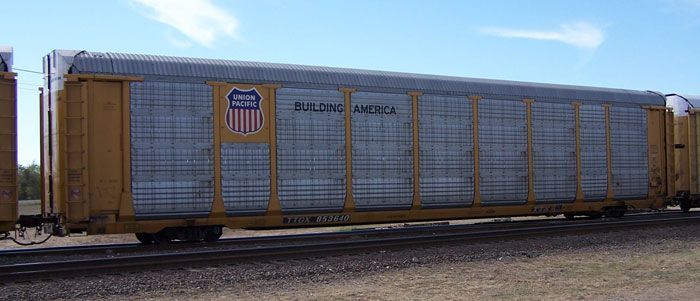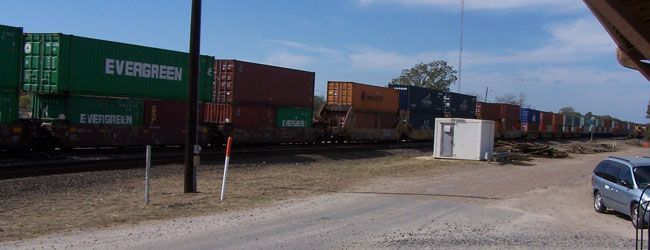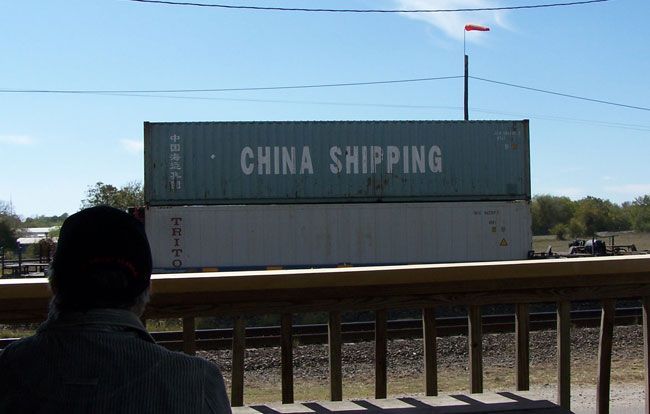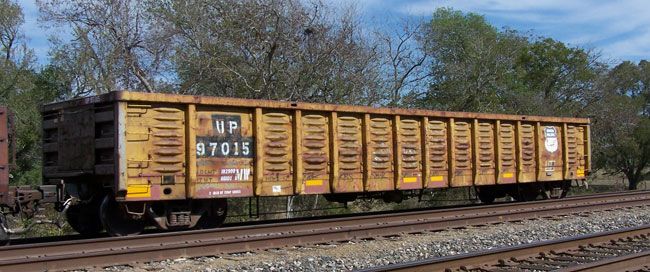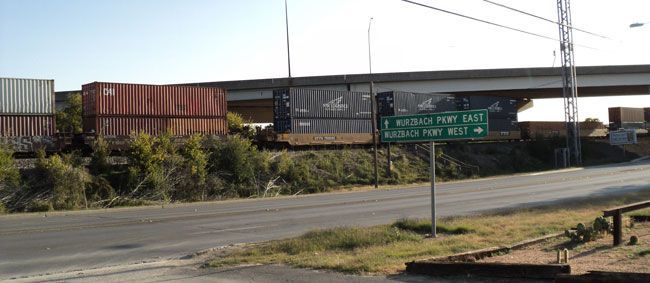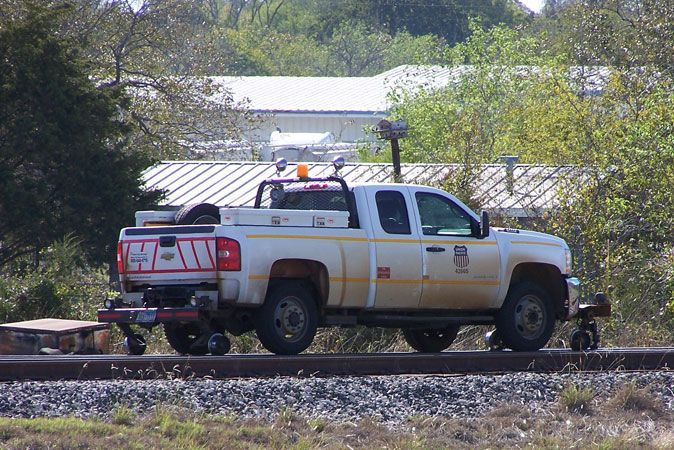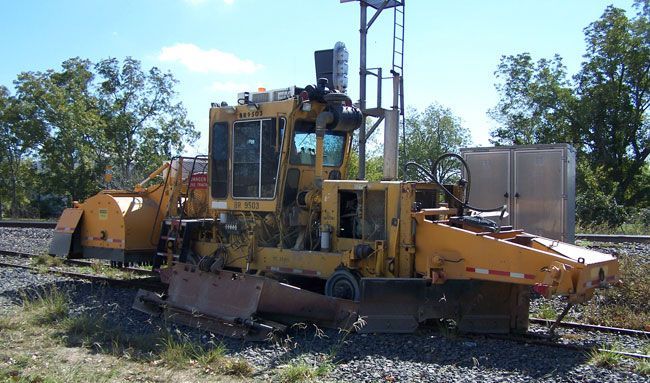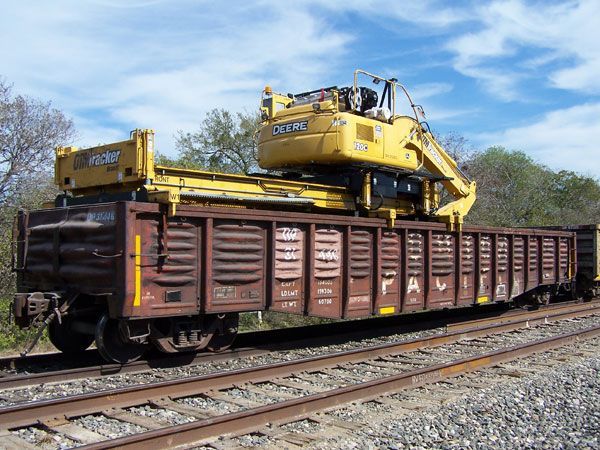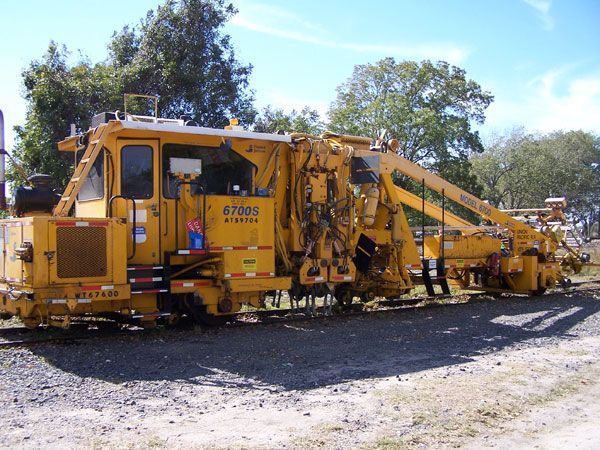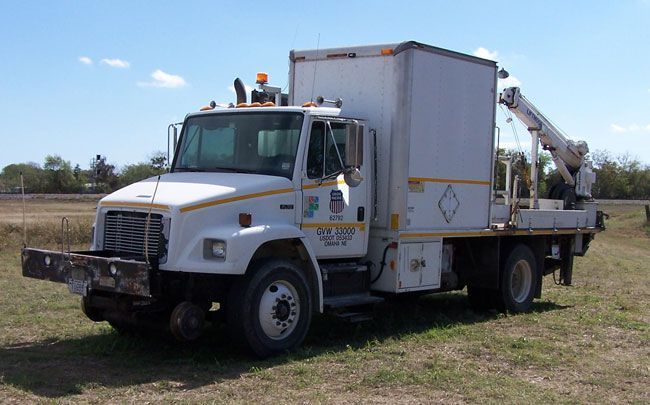Union Pacific Railroad in San Antonio

TTM is proud to have the Union Pacific as a sponsor
of the "San Antonio Train Show," hosted by the
Alamo Model Railroad Engineers for 24 years
The Union Pacific became part of the San Antonio railroad landscape in 1980 when the company merged with the Missouri Pacific which first arrived in the city in 1881. Over the next sixteen years they also acquired the Missouri-Kansas-Texas and the Southern Pacific and have become the sole proprietor of all the main lines and rail yards in the city. The UP is the largest railroad in the USA. It operates over 40,000 miles of track and also has the highest revenues. It is one of the very few railroads that never changed its name since its beginnings in Nebraska in 1863. It was chartered by the US government to build westward a transatlantic route to California from Omaha, Nebraska. The Central Pacific, which would later become the Southern Pacific, was simultaneously chartered to build eastward from California, with the intention that the lines would meet along the surveyed route. This became something of a race, with enormous land grants at stake. Eventually, Promontory Point in Utah became the place where the two lines became one, and the enormous project helped to unify the nation during the turbulent years of the civil war.
The Union Pacific's rise to its current position is well recorded in many places. Its arrival in San Antonio and its eventual ownership of all the rails serving the area is the focus of this narrative. It began in 1980, when the planned merger of the Union Pacific, Western Pacific and Missouri Pacific railroads was announced. The resulting railroad would have 22,800 miles of track. Of this, the old Union Pacific made up just 9,420 miles. Western Pacific was around 1,911 miles. The largest part of the new company, which would be known as Union Pacific but legally called Pacific Rail Systems, came from the Missouri Pacific, 11,469 miles. The first hurdle was the Interstate Commerce Commission. The ICC had had its powers significantly reduced by the Staggers Act of 1980, and so its merger oversight was a lot less arduous than had been the case for so many mergers up until this point. It also meant that the "new" railroad would be allowed to streamline its business with far fewer regulations and restrictions. The merger was fought vigorously by as many as ten other railroads. Significantly, these included its two main competitors in the western US, the Southern Pacific and the Santa Fe. However, with the granting of various trackage rights to ensure competition, the ICC approved the merger in September of 1982. The case ended up in the Supreme Court. It ruled in favor of the new conglomerate at 2:55 PM on December 22, 1982.
Recent images of the Union Pacific in San Antonio
Union Pacific, MOPAC, KATY & Southern Pacific System Maps
The new arrangement proved to be mutually beneficial to both railroads. The UP continued to serve all points west from Omaha and the Missouri Pacific to serve south and south west from St. Louis. There was little in the way of overlap. The new company did not abandon any Missouri Pacific routes. It was a good fit. The UP still uses the old MP South San yard, and still goes to Laredo, Corpus Christi and Dallas / Fort Worth from San Antonio. Little by little, the MP's identity began to wane. Interestingly it would not fully cease to exist until 1997, when the company was fully merged into the parent Union Pacific, one year after the acquisition of the Southern Pacific. To this day you will still see a lot of rolling stock with its original MOPAC budging and paint work, but not any locomotives, since the MP adopted the UP's yellow and grey paint scheme as early as 1984. The old MP depot in San Antonio is now the head quarters of a credit union. One or two other MOPAR depots also exist in the area, most notably the one in New Braunfels, which is now a museum.
San Antonio area detail plus Union Pacific and BNSF System Maps
Absorbing of the Missouri-Kansas-Texas took a lot less time and a lot less fuss. It is worth mentioning that the original name of the MKT was the Union Pacific (Southern Branch) but it was never a part of the Union Pacific until 1988. The MKT was a true independent. It built all its own lines and never expanded by taking over other railroads, unlike both the Missouri Pacific, the Southern Pacific and the Union Pacific which became such enormous systems through acquisitions. While there was quite a degree of duplication of service with the Missouri Pacific and the Missouri-Kansas-Texas, the acquisition of the MKT gave the Union Pacific a direct line to the Midwest through Oklahoma, and also provided a direct route to Houston from San Antonio. The UP had been leasing trackage rights from the Katy for many years. The MKT had been struggling to survive on its own and its parent company, KATY Industries, which still survives, was quite keen to see its railroad business spun off.
Retired Union Pacific Caboose at Texas Transportation Museum
Within San Antonio and the surrounding area, a fair amount of MKT lines were abandoned, including its freight terminal on Durango Boulevard and its main yard near the Stockyards, just south of downtown. Some seventeen miles of MKT tracks were removed as superfluous in New Braunfels, but the UP was smart enough not to give up the right of way. This came in handy in April of 1998 when it was decided to rebuild them. Today it is very rare to see any MKT rolling stock but one or two items are still around. There are almost no KATY depots left. Even the one in Smithville, which was a major junction point for the MKT, is not original to the town. It comes from a smaller town along the line as the original Smithville depot was destroyed in a fire many years ago. Once the UP acquired the Southern Pacific certain parts of the MKT's lines into Houston were also abandoned as they were deemed a duplication of the more direct lines of the SP and it would have been next to impossible to connect them with the old SP's freight terminals.
Union Pacific Trains in Various Locations Around San Antonio
The second acquisition of the Southern Pacific by the Union Pacific in 1996 was a lot less troublesome than that of 1900. The first merger was fought vigorously. The Interstate Commerce Commission was at its zenith at that time but, even so, it took thirteen years for the Southern Pacific to regain its independence. Following the 1982 merger of the Missouri Pacific and the Union Pacific, which the Southern Pacific fought all the way to the supreme court, the SP felt it had to join with another large railroad that served the Midwest if it was going to be able to compete. Towards that end, it announced it was going to merge with the Atchison Topeka & Santa Fe railroad. The SP would have lost much of its identity in this merger but the writing was on the wall, and consolidated mega railroads were becoming the wave of the future. Ironically, the merger was not approved by the ICC, even though they had gone so far as to begin painting locomotives in the joint companies new color scheme. Following this failure, the Santa Fe would go on to merge with the Burlington Northern, itself the result of many railroads uniting. In 1988, the Southern Pacific was bought by Rio Grande Industries, the parent company of the Denver & Rio Grande Western Railroad, but the resulting railroad was given the name of Southern Pacific Lines.
Just a few traces of the MK&T in San Antonio still exist
See link on right for more on UP hertiage equipment in San Antonio
On November 30, 1995, the Union Pacific filed its plans to merge with the Southern Pacific with the ICC. However, on Jan 2, 1996, the ICC, the nation's oldest regulatory body, was abolished and replaced with the three person Surface Transportation Board. The ICC had been stripped of its oversight authority by the 1980 Staggers Act, but it was obviously still strong enough to nullify the SP / ATSF merger. Its deliberations took time. The new STB, however, acts with relative alacrity, and the merger UP / SP merger was approved on July 3, 1996. A few concessions had to be made, one of which was allowing the new BNSF, the Burlington Northern Santa Fe, some trackage rights in the San Antonio corridor. This became a very serious matter a few years later when Toyota was still deciding whether or not to build a new plant in San Antonio, but we will get to that issue in due course.
Some Local Union Pacific Images From 2003
Very little, if any, Southern Pacific assets have been abandoned in this area. Both of its yards in San Antonio, East yard and the larger Kirby yard, just a little further out to the east, are as busy as ever. The company's main office in the area is at the old MOPAC yard on the west side of the city. Almost simultaneously with the takeover of the SP, but with no connection whatsoever, the historic SP Sunset Station was renovated and converted into an entertainment complex. Some old SP depots survive, including the one formerly located at Converse, which was moved to the Texas Transportation Museum in 1968. There is another one in Hondo. By all accounts, incorporating the SP into the UP empire has not been easy. They both have a long established culture. More than this, the UP states it faced unexpectedly vast expenditures improving and modernizing SP lines. After seven years, what was always described as a merger is all but complete, and the SP's identity is just about gone. You still can see a lot of SP rolling stock but fewer and fewer locomotives. Those that have yet to be repainted have yellow rectangles under the cab indicating the unit's new UP number.
With the absorption of the Southern Pacific, the Union Pacific became the biggest railroad in the USA. It operates over the western two thirds of the nation. Within its area, it only has one rival, the BNSF. There are only nine class one railroads left in the country following all the mergers. Railroads have evolved into specialty carriers of enormous amounts of freight. Long gone are local mixed freight trains. What you see today are unit trains, or trains carrying just one commodity. Frequently these can be as much as a mile and a half in length. It remains true that just about everything available has been moved at some point or another in the supply chain by rail. In March of 1998, the UP and the BNSF created a joint regional dispatching center for the entire gulf coast area, which is located in Spring, Texas. This makes sense as each has trackage rights on the other's system. Additional to the cost benefit of only having one set of staff and equipment, it should make the movement of both company's trains both safer and more expedient.
The Union Pacific's monopoly of rail service in the San Antonio area became a front page, banner headline, issue in 2002. Toyota, the car and truck manufacturer, made it very clear that the UP's monopoly in San Antonio was a major problem with regards to choosing the city for its proposed new assembly plant. While San Antonio was on the company's short list, it wanted to be able to use more than one rail carrier if at all possible. State and city leaders were doing everything they could to attract such a plumb employer to the area, which substantially lacks a manufacturing element. The possible site that Toyota was looking at is very close to the line from San Antonio to Corpus Christi, the old Missouri Pacific, indeed the old San Antonio Uvalde & Gulf, line. Upsetting the apple cart, Union Pacific essentially refused to allow any other carrier to have trackage rights on the line. The UP's position was, "We built it, we own it and we won't share it." The 'built' part is a bit of a stretch, but that was the only amusing element about the statement, particularly to city leaders. The UP's position was quite defensible and not only legally. It is also worth noting that the UP takes care of over 70% of Toyota's rail needs in the USA. What Toyota does not want is to be at the mercy of railroad unions. (Toyota is not the most friendly company when it comes to unions in general.) There was a major railroad strike in 1998 and the new plant could not be productive if such an action was ever to be repeated.
What happened next was really just negotiation by headline. State and city representatives went into full battle mode over the issue. County judges issued not so subtle threats about what they would do to the UP if the city lost its bid to get Toyota over rail service. The situation resolved when it was realized that another railroad, the BNSF, had trackage rights to come through San Antonio on the former SP line to Del Rio. A plan to build a spur line to the plant from the other side, as it were, at city expense, was being seriously promoted. The BNSF had gained trackage and service rights through San Antonio as part of the deal with the Surface Transportation board that allowed the UP to merge with the SP. While they began moving trains through the city in 1997, they had yet to become a service supplier to any company within the city. Toyota would certainly be attractive enough to make them want to start. The brinksmanship worked. Union Pacific relented and said the BNSF could have trackage rights along the Corpus Christi line. And why not? They would have to pay for such rights so it is a win / win situation for the UP. Not long after, Toyota announced it would build in San Antonio, which should be quite a boost to what has always been a low wage economy. Some time later, the plans to build the new spur line, which has already been published in the media, were quietly shelved, and all seems to be well. It is yet to be seen if BNSF will get a slice of the Toyota transportation pie. One can only imagine the UP will do whatever it takes to shut them out. In this regard at least, nothing much has changed since the very earliest days of railroading. Keep the others out at all costs. This dictum and that rails are four feet eight inches apart maybe the only things that have not changed since railroading began. They are the ultimate fundamentals.
The year's following 204 have been very quiet for the UP in San Antonio, much to everyone's relief. A new superintendant was installed and new safety policies instituted and slowly the railroad faded back into the background, just one rung above utilities such as power lines and underground water and sewage service. And yet there were some significant developments. A private company now runs a rail switching service at Port San Antonio, the former Kelly Air Force Base operation, relieving the UP of this responsibility. For its part, the UP invested tens of millions of dollars in a state of the art multi-modal freight yard on the south-west out skirts of the city just a little shy of Von Ormy near IH 35. This facility allows trucks to pick-up and deliver containers in a very efficient manner, cutting congestion at both the UP's older yards and the road system to boot. But even this development, which allowed the UP to effectively reduce all but switching activities at East Yard, which dates back all the way to 1877, was played out in a very low key way. Beyond a few mentions in the business section of the local paper, the major investment went all but un-noticed. Apparently no news is better than even good news.
San Antonio railroad grade crossings, bridges and underpasses
For most people in San Antonio, their only interaction with the railroad in San Antonio is at grade crossings. It would have to be said that this relation is one of frustration, which often leads to tragedy, for everyone concerned. Drivers and pedestrians ignore barriers, flashing lights and ringing bells with alarming frequency, often with deadly consequences. The railroad has constructed as many over and under passes as possible and works diligently to avoid the flow of street traffic as much as possible but it has to be remembered that very often the tracks were there first, laid across empty territory. Railroads, at least in their early days, tended to spur development, which lead to the road crossings we now have to deal with every day. Another complaint is noise. The Union Pacific began installing redesigned crossings that are supposed to make it very difficult for impatient drivers from getting around them which legally allows the train to pass through without sounding their incredibly loud horns. These in turn are not always popular as they restrict traffic flow when there are no trains passing. Keeping foolhardy motorists safe is never easy.
Snaps of Union Pacific equipment in Flatonia and San Antonio in 2011
UP in San Antonio Timeline
━━━━━━━━━━━━━━━━━
1851
The Missouri Pacific RR is formed
━━━━━━━━━━━━━━━━━
1863
The Union Pacific RR is formed
━━━━━━━━━━━━━━━━━
1980
The Union Pacific merges with the Missouri Pacific
━━━━━━━━━━━━━━━━━
1984
Missouri Pacific trains adopt the UP's yellow and grey paint scheme
━━━━━━━━━━━━━━━━━
1988
The UP acquires the M-K-T (Missouri-Kansas-Texas) RR
━━━━━━━━━━━━━━━━━
1996
The UP acquires the SP (Southern Pacific) RR, becoming the sole rail operator in San Antonio. The BNSF (Burlington, Northern, Santa Fe ) RR is allocated limited trackage rights between Houston and Eagle Pass by the Federal government to maintain a semblance of competition in the area.
━━━━━━━━━━━━━━━━━
2002
Limited trackage rights to the new Toyota plant on the south west of San Antonio are granted to the BNSF as part of the package demanded by the automobile manufacturer to build here
Transportation Museum
CONTACT US TODAY
Phone:
210-490-3554 (Only on Weekends)
Email:
info@txtm.org
Physical Address
11731 Wetmore Rd.
San Antonio TX 78247
Please Contact Us for Our Mailing Address
All Rights Reserved | Texas Transportation Museum
